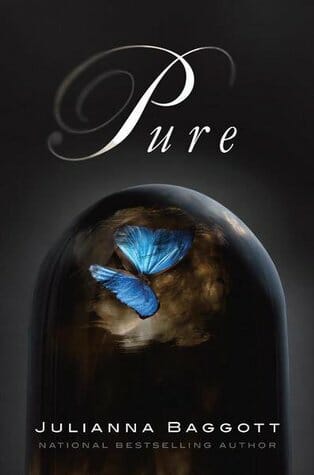Pure by Julianna Baggott
Daring to See the Blindside

Dystopian fever grips our world.
The Hunger Games movie opened to generally copious praise and astonishing box office numbers—grossing $153 million opening weekend and nearly $680 million at this printing. Dystopian TV shows, such as the upcoming Revolution on NBC, pop up across the networks. New young adult dystopian series, like Veronica Roth’s Divergent series or Marie Lu’s Legend series, appear just about every week (or so it seems).
At first blush, Julianna Baggott’s Pure might appear to be just another novel riding this YA dystopian wave. Her novel, however, brings a great deal more to the table. She blends together prototypical new feminists and inventive Machiavellian schemes for a new world order inextricably linked to depleting natural resources, atomic bombs and genetic mutation. She teases these themes out to imminently possible—and absolutely terrifying—extremes. Doing so, Baggott crafts a richly nuanced dystopian landscape that begins where Hunger Games and many other YA dystopias end.
Besides an intriguing story, Pure also tackles one of the greatest mysteries in the worlds of dystopian literature today: How did things get so bad?
In many of these novels, the dystopias exist in a distant future, far removed from events that led to the dystopian state. Too many books gloss over these inherently fascinating genesis events for the sake of simply getting the reader quickly beyond the collapse and restructuring of the society and right into the story. The past becomes obscure, something like the ubiquitous and blinding fog of Cormac McCarthy’s post-apocalyptic landscape in The Road. Readers understand transforming events have happened, but never truly perceive them.
Importantly, the reader gets an unwarranted reprieve—intentional or not, recognized or not—with such hazy, abstracted depictions of social decline.
Pure begins another way. Baggott’s world stands mere years from the bombings that created the desolate and dying terrains of her novel. These bombings, which stratify survivors, leave “Pures”—people with bodies unmarred, who live safely in a place called the Dome—and the rest of humankind, genetically mutated and physically disfigured, who struggle for survival in the desolate remaining world.
Pressia and Partridge, 16 and 17 years old respectively, remember the world before, even as they filter the new world through awakening young adult consciousness. The youngsters live vastly different lives. Partridge receives shelter and nurture as one of the chosen few who live inside the Dome. Pressia struggles outside to survive in a world devastated by Detonations. When Pressia becomes a fugitive, fleeing from militias that will either use her for target practice or induct her into their murderous ranks, and Partridge escapes the Dome, searching for the truth about his mother, worlds collide and realities shatter.
Baggott presents a crystal-clear image of the warring ideologies that caused the orchestrated apocalypse. She deliberately traces the ways those ideologies linger on to inform the brave new world that emerges from a man-made Judgment Day. This element—naming cause—elevates her fiction in Pure from the rank-and-file of dystopian works of today.
Baggott’s book will remind many readers of Octavia Butler’s Parable novels (Parable of the Sower, 1993, and Parable of the Talents,1998). Both bodies of work occupy the same sort of in-between zone, at a fictional level and on a meta level. Butler’s novels, just as Baggott’s Pure, do not depict a society already sunk into some abyss of fascism, a trope that with tiresome frequency is a de facto setting for dystopian novels. Instead, Butler’s novel shows American society in the midst of steep decline. It coalesces in a vision of a nation where fundamental natural resources like water grow scarce and costly, while unnecessary resources like gasoline prove equally difficult to come by.
Butler’s novel imagines the trajectory of a nation that finds employment, housing, and safety in short supply. She does not gloss over those issues. Instead, she confronts them, unflinchingly and deliberately. Doing so, she also forces her readers to confront cultural degeneration in all its gritty, violent magnificence.
-

-

-

-

-

-

-

-

-

-

-

-

-

-

-

-

-

-

-

-

-

-

-

-

-

-

-

-

-

-

-

-

-

-

-

-

-

-

-

-








































